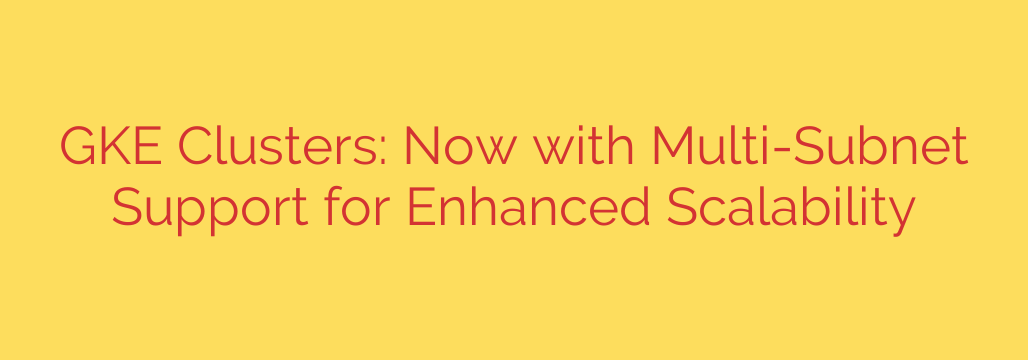
Unlock Ultimate GKE Scalability: A Deep Dive into Multi-Subnet Support
As Kubernetes adoption matures, organizations are pushing the boundaries of what a single cluster can do. This rapid growth often leads to a critical, yet frequently overlooked, bottleneck: IP address exhaustion. For a long time, Google Kubernetes Engine (GKE) clusters were constrained to a single subnet, creating a hard ceiling on scalability. When you ran out of IP addresses in that subnet’s secondary ranges, your only options were complex workarounds or a complete cluster migration.
Today, that limitation is a thing of the past. GKE now supports multi-subnet clusters, a fundamental shift in networking that directly addresses the challenges of large-scale deployments. This enhancement allows a single GKE cluster to utilize IP ranges from multiple subnets within the same Virtual Private Cloud (VPC), providing a powerful new level of flexibility and scale.
The Core Challenge: IP Address Scarcity
In a standard VPC-native GKE cluster, Pods and Services receive their IP addresses from secondary IP ranges associated with the cluster’s subnet. As you add more nodes, deploy more Pods, and expose more Services, these IP pools begin to deplete.
For large enterprises running massive, multi-tenant clusters, this becomes a significant operational hurdle. A single subnet, even a generously sized one, can prove insufficient. This forced teams to either create sprawling, difficult-to-manage subnets or provision multiple smaller clusters, adding architectural complexity.
How Multi-Subnet Support Changes the Game
With this new capability, you are no longer locked into a single subnet for your cluster’s networking needs.
A single GKE cluster can now seamlessly span across multiple subnets within the same region and VPC. This means you can assign secondary IP ranges from different, non-contiguous subnets to your cluster for Pods and Services. When one range is exhausted, GKE can automatically begin using IPs from the next available range in a different subnet, ensuring smooth, uninterrupted scaling.
Key Benefits of a Multi-Subnet Architecture
Adopting a multi-subnet strategy for your GKE clusters unlocks several powerful advantages that directly impact scalability, management, and network design.
1. Unprecedented Scalability and Growth
This is the most significant benefit. By breaking free from the single-subnet limit, you effectively remove the primary network-related barrier to cluster growth. You can now scale your clusters to sizes that were previously impractical by simply adding new subnets to the cluster’s IP pool as needed. This is ideal for applications with unpredictable or explosive growth patterns.
2. Enhanced IP Address Management (IPAM)
Network administrators no longer need to find and reserve a single, massive, contiguous CIDR block for a GKE cluster. Instead, they can allocate smaller, available IP ranges from various subnets. This flexibility dramatically simplifies IP planning and allows for more efficient use of your VPC’s address space. It helps integrate GKE more smoothly into established enterprise network topologies.
3. Improved Network Organization
Multi-subnet support offers new possibilities for logical network segmentation. While all subnets must reside in the same VPC, you could potentially use different subnets for different types of workloads or node pools within the same cluster. This can help align your Kubernetes networking with broader organizational policies for traffic management and resource grouping.
4. Future-Proofing Your Infrastructure
By designing your clusters with multi-subnet capabilities from the start, you are building a more resilient and adaptable platform. You can begin with a modest IP allocation and confidently expand it later without requiring disruptive network changes or cluster migrations. This proactive approach ensures your infrastructure can handle future demands without a major re-architecture.
Actionable Security and Planning Tips
While GKE handles the complexity of routing between these subnets, it’s crucial to approach this with a clear strategy.
- Plan Your IP Space: Before adding subnets, map out your IPAM strategy. Ensure the subnet ranges you add do not overlap and are logically organized to prevent future management headaches.
- Leverage VPC-Native Features: This capability is built on the power of VPC-native clusters (using Alias IPs). Ensure you are using this mode, as it is the standard for modern GKE networking and security.
- Review Firewall Rules: Your existing VPC firewall rules will continue to function as expected. As you add subnets, review your rules to ensure they correctly cover the new IP ranges and provide the intended security posture for traffic entering and leaving your Pods.
- Embrace Network Policies: For granular, intra-cluster security, continue to rely on Kubernetes Network Policies. These policies operate at the Pod level (using labels) and are independent of the underlying subnet topology, providing a consistent layer of defense regardless of how many subnets your cluster spans.
In conclusion, the introduction of multi-subnet support is a pivotal evolution for Google Kubernetes Engine. It directly solves the critical issue of IP exhaustion, empowers administrators with unprecedented flexibility, and solidifies GKE’s position as a platform built for hyper-scale workloads. For any organization running large GKE clusters or planning for significant growth, this feature is not just an improvement—it’s a game-changer.
Source: https://cloud.google.com/blog/products/networking/multi-subnet-support-for-gke-clusters-increases-scalability/








